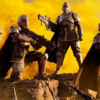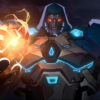In the ever-evolving landscape of superhero video games, Marvel Rivals and Marvel Avengers stand out as two major titles that have captured the attention of Marvel fans worldwide. Both games present the beloved universe of Marvel superheroes in unique ways, but one key aspect that sets them apart is their approach to character costumes and the visual identity of these iconic figures. In this article, we will explore the significance of costume design in both games, discuss the impact these designs have on the overall gameplay experience, and delve into how these design choices affect the depiction of enemies and heroes alike.

The Power of Costume Design in Marvel Rivals and Marvel Avengers
Costume design is more than just a cosmetic detail in superhero games. It plays a crucial role in conveying a character’s personality, background, and powers. In both Marvel Rivals and Marvel Avengers, the character outfits do more than simply clothe the heroes and villains—they become a powerful tool for immersion and storytelling.
Marvel Rivals: A Vibrant Comic-Inspired Style
Marvel Rivals has garnered attention for its comic book-inspired aesthetic. The game embraces the bold, colorful costumes that are characteristic of Marvel Comics. Every hero and villain is represented with costumes that stay true to their roots, capturing the vibrant and exaggerated nature of their comic book appearances. This design choice not only appeals to longtime Marvel fans but also attracts newcomers with its stylized visuals.
One of the most significant advantages of this approach is the way it creates a clear distinction between characters. For example, Spider-Man’s red-and-blue suit or Iron Man’s iconic armor stand out with their distinctive colors and designs, making it easy for players to identify each character instantly. The costumes in Marvel Rivals are designed to evoke a sense of excitement and dynamism, fitting the fast-paced action that the game offers. Every battle feels more like a living comic book, where the clash of heroes and villains is accentuated by their bold outfits.
Marvel Avengers: A Realistic Approach with Mixed Reactions
On the other hand, Marvel’s Avengers takes a more realistic approach to its characters’ costumes. The design of the costumes in this game reflects the modern, grounded tone of the Marvel Cinematic Universe (MCU), aiming for more functional and tactical designs rather than flashy comic-book representations. Characters like Captain America and Thor are outfitted in suits that resemble military gear or high-tech armor, and the detail in these costumes is intended to make the characters look more believable in a real-world setting.
While this approach provides a more mature and cinematic feel, it has garnered mixed reactions from fans. Some players appreciate the realism and the intricate details in the costumes, such as the textures of Captain America’s shield or Black Widow’s tactical suit. However, others feel that these realistic designs lack the colorful flair and over-the-top heroism that comic book fans expect. The grounded approach sometimes leads to an overwhelming sense of uniformity, where heroes who were once larger-than-life figures are presented as mere soldiers or mercenaries.
Costumes as a Reflection of Enemies and Heroism
Costumes in both games are not just limited to heroes. Villains, too, are an essential part of this equation. Marvel Rivals and Marvel Avengers each handle villain design differently, reflecting their respective game styles and the overarching narrative tone they strive to achieve.
Villains in Marvel Rivals: Over-the-Top Threats
In Marvel Rivals, the villain designs maintain the same boldness and vibrancy as the heroes. Figures like Green Goblin or Thanos are depicted in larger-than-life costumes that are designed to stand out against the brighter colors of the protagonists. The exaggerated designs make it clear that these are not just enemies to defeat—they are the epitome of evil, with costumes that emphasize their menacing presence. These designs are theatrical and create a sense of imminent danger whenever they appear on the screen.
Villains in Marvel Avengers: More Grounded and Tactical
In contrast, Marvel Avengers opts for a more tactical, realistic approach to villain design. Characters like Modok or AIM agents are presented with a more militarized look that aligns with the game’s overarching sense of realism. This change from classic comic book villainy to a more realistic threat helps maintain the serious tone of the game but can sometimes reduce the impact that villains have on the player’s experience. Villains in this game are more often seen as strategic enemies rather than larger-than-life threats.
The Impact of Costume Design on Gameplay and Player Engagement
The choice of costume design plays an important role in how players interact with the game world and the narrative. In Marvel Rivals, the comic-inspired costumes create an engaging, visually appealing environment where the player feels like they are part of a living, breathing comic book adventure. The over-the-top visuals of the heroes and villains elevate the excitement of every combat encounter, and the dynamic color schemes enhance the fast-paced action.
In Marvel Avengers, the realistic approach to costume design aims to provide a more cinematic experience. The detailed armor and tactical outfits enhance the player’s sense of immersion, making them feel like they are a part of a high-stakes, real-world battle. While the game may lack the vibrant colors and exaggerated designs of the comics, its realistic tone appeals to players who prefer a grounded, mature superhero experience.
The Future of Costume Design in Marvel Games
As both Marvel Rivals and Marvel Avengers continue to evolve, the question of costume design remains an important consideration for the future of superhero gaming. With the introduction of new skins and updates, both games have the opportunity to further refine and expand their approaches to character outfits. For instance, Marvel Rivals may continue to embrace the bright, comic-style designs that fans love, while Marvel Avengers could experiment with more cinematic and creative skins that blend realism with the epic nature of the source material.
Furthermore, as players become more invested in customizing their heroes, it’s likely that skin options will play an increasingly significant role in how players engage with these titles. Whether it’s through seasonal skins, crossovers with the MCU, or exclusive designs, costumes will remain a key aspect of the player experience in both games.
Conclusion: A Costume War Worth Watching
The costume design in both Marvel Rivals and Marvel Avengers serves as more than just a visual element—it is an integral part of how these games depict the battle between heroes and villains. Each game’s approach to costume design reflects its broader tone, gameplay, and target audience, with Marvel Rivals opting for a bold, comic-inspired aesthetic and Marvel Avengers taking a more realistic, tactical route. Whether you prefer the dynamic flair of Marvel Rivals or the grounded realism of Marvel Avengers, there’s no denying that costume design will continue to play a pivotal role in the ongoing battle for superhero supremacy in the gaming world.

